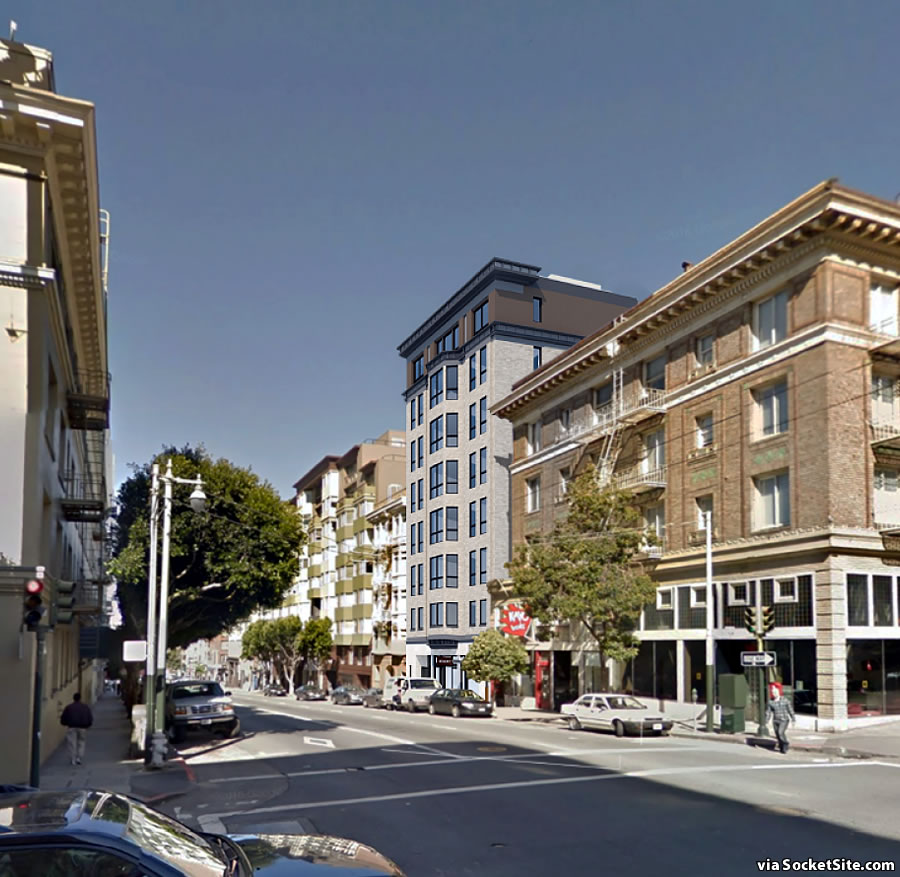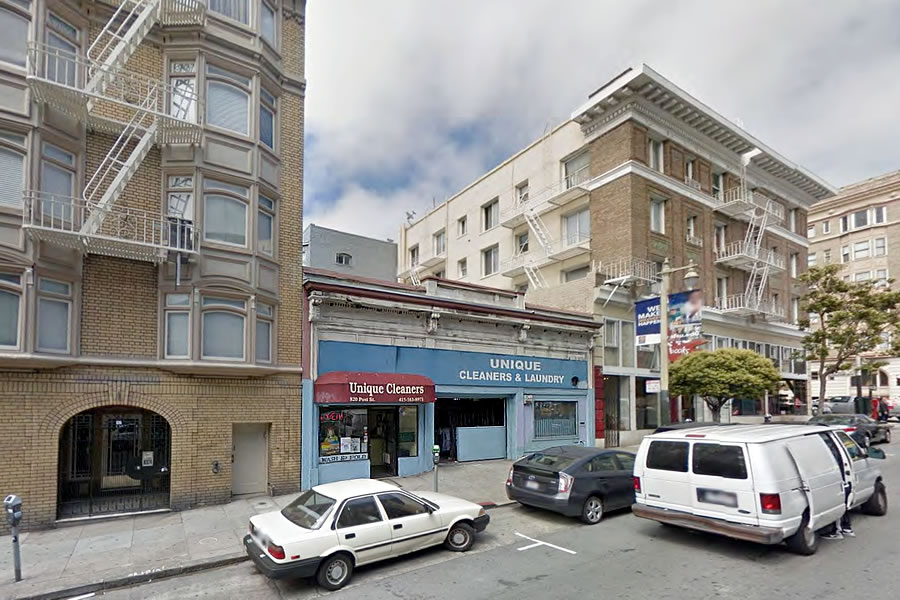Purchased for $1.528 million in August of 2016, the rent for the Unique Cleaners building at 820 Post Street was then raised, the business was forced to shutter, and plans to level the building and redevelop its Tenderloin parcel were drafted, refined to include traditional bay windows and a contrasting top floor, and then approved last year.
A demolition permit was set to be issued for the project, pending the issuance of a building permit for the approved development which was to yield a new 8-story building with 12 apartments – a mix of 5 one-bedrooms, 6 twos (one of which would be offered at below market rates) and 1 three-bedroom penthouse unit with a private balcony – over a 1,200-square-foot retail or café space.
And while a building permit for the project was in the works and close to being issued, a downsized set of plans for the project were recently drawn, eliminating the approved 8th floor and penthouse unit, and the entitled project site and since value-engineered plans for a 7-story, non-high rise building, with 11 residential units over a ground floor commercial space, are now back on the market with a $2.788 million price tag rather than being prepped to break ground.




“the rent…was then raised, the business was forced to shutter, and plans to level the building and redevelop its Tenderloin parcel were drafted,”
Please explain to me the reasoning of those who can’t appreciate the clear beauty of ‘creative destruction’…I just can’t understand it.
People who don’t cotton to creative destruction are like those who are skeptical of the fiscal soundness of the bold, disruptive, risk-taking entrepreneurs with disruptive plans to borrow money from their investment banker frat bros to overpay for edgy SOMA “creative spaces” and hire barely post-pubescent but still disruptive video game addicts to code disruptive taco delivery apps that absolutely nobody will ever use (except for a few disruptive early adopters who will briefly use the app during its promo phase and gets lots of free tacos delivered, and then promptly drop it once the disruptive appholes start asking for money).
Please explain to me what this has to do with creative destruction? I’m no fan of Schumpeter, but I have read him, and I’m not seeing the parallel.
“capitalism …must ceaselessly devalue existing wealth … for the creation of new wealth”
The post was meant to be a parody of people who mindlessly push new projects – presumably b/c of long-term benefits – but ignore the side effects; I thought presenting a selectively edited portion of the article (that highlighted the latter) along with a bunch of development platitudes would make the dissonance clear, but apparently not.
Of course one could flip that narrative on its head and argue the problem(s) is really the slow pace of development – thus a governance issue – but we have to deal with the “is”ness of things: a long time business shuttered and added to the gut of empty storefronts…for 4 years.
P.S. I actually think the proposal isn’t half bad…too bad it has to carry baggage around.
Why not split the penthouse floor into 2 units as opposed to eliminating it? Don’t get the logic on that. It makes no never mind – in today’s “new” order these entitled mid-sized projects are defunct. The city is emptying out but, at the same time, construction costs remain the highest of any city in the world. No way they get $2.788 million – not even close.
I don’t know the details of this case, but reducing the building height may have allowed them to switch to a more affordable construction type, which can reduce overall costs considerably.
The choice of construction types is driven, in part, by building codes rather then engineering requirements. Codes limit the height of certain construction types.
In this case, by reducing the height by one story, they may have been able to switch the entire building to a cheaper sort of construction.
I thought the cutoff point was going from 6 to 7 stories. Of course the criteria is physical height and not necessarily number of stories given that ground floor height and individual floor height can vary.
I would think it’s a combination of the two: floor loads – i.e. the number of stories – affect the compressive forces, though the building code cutoffs probably have such a big factor of safety that the compressive strength of a 2×4 is never really much of an issue. And I believe the codes – at least for this criteria – DO reference stories rather than actual height.
I’m a transportation planner, not an architect, so this is not my area of expertise. However, my understanding from this article is that the 2015 edition of the International Building Code made it legal to build 5 stories of wood-frame over a two-story concrete or masonry podium, for a total of 7 stories.
My understanding is that previous versions of the International Building Code limited the concrete podium to no more than one story above grade. So perhaps the architects value-engineered the project by switching from a more expensive noncombustible Type I or II 8 story building, to a 7-story building with 5 stories of woodframe over a 2-story concrete or masonry podium?
I like the proposal WITH the penthouse… For economic reasons and aesthetic ones, it was good.
What the hell makes the 6 story version a better deal for the public and the “housing shortage.?
world is changing